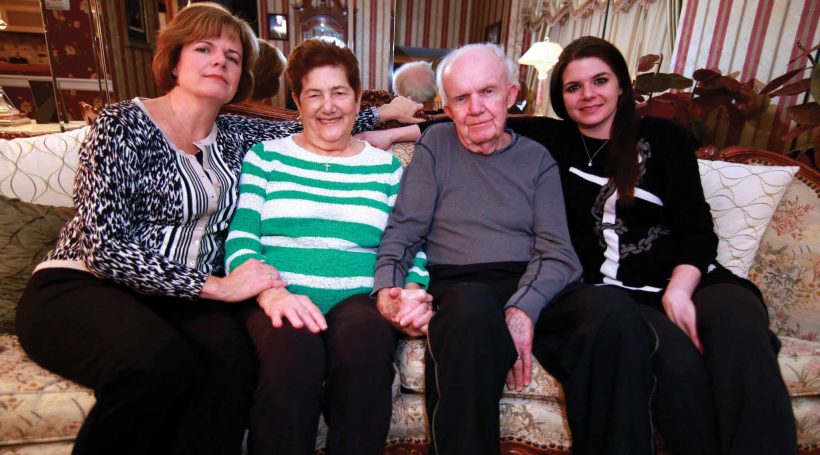Rose Breen has made decisions before in her 82 years on Earth, but the one to pursue chemotherapy a second time in less than a year was unlike any other. Deciding whether to treat two different cancers in such a short period of time wasn’t something she took lightly. It was also a dilemma that, had she been younger, she wouldn’t have been asked to consider.
Breen was encouraged by the lack of severe side-effects during her first cancer treatment for lymphoma last May. But it was harder to agree to chemotherapy for the rare blood disorder myelodysplastic syndrome, which showed up months later. To even get to the treatment phase, Breen needed a bone marrow biopsy, says her daughter, Joan Janosko.
“We heard all the options, the big and small scenarios, what would happen, and the results. We agonized over it,” says Janosko of the decision to pursue chemo-therapy a second time. “It mattered that she could decide on her own. As long as she looked the doctor in the eye and said she wanted it, we decided to resume treatment. Her doctor never said, ‘Let’s rule out treatment.’ He didn’t treat her like a statistic.”
The fact that Breen was given treatment options is a departure from standard practices of decades ago. The medical community once refrained from treating those over a certain age, believing elderly patients were too fragile to be helped. Today seniors and doctors are more in sync about goals and care, but how to proceed once a diagnosis is handed down is still a multilayered decision.
“Up until the 1970s, the model was doctors were expected to make decisions for patients. They were deemed to know best,” says Michael Gentzel, a Rutgers University-Camden philosophy instructor. “Today, pretty much all medical ethics uphold the rights of patients in all circumstances. If you are 104, you may be the oldest person on record, but a healthcare provider is not making value judgments. No one is saying, ‘You are 104. You should be left to die.’”
This transformation in medicine has been twofold. The advent of informed consent, where information is presented to a patient prior to any decision, plus an increased acceptance of second opinions, have opened doors to patient empowerment, says Gentzel, who teaches a course in biomedical ethics.
Doctors may have once felt they were acting in the best interests of their patients, considering the medical resources of a half-century ago. Chemotherapy, surgery and radiation posed risks for an older person that could outweigh the benefits.
“There was a fear about side effects,” says Generosa Grana, MD, director of the MD Anderson Cancer Center at Cooper. “Now we are more confident that should an older person have cancer, they could tolerate chemotherapy well.”
Treatments have become more sophisticated, drugs are gentler and doctors discuss – rather than dictate – options with their patients, adds Grana. But even armed with information and patient rights, families of seniors may still struggle with a healthcare decision when treatment side effects like infection, nausea and fatigue are possible. Janosko, her three brothers and their 80-year-old father Harry know this all too well.
“What do we do if it doesn’t work? What is the purpose? Everything was entirely focused on and talked about,” says Janosko, who lives in Mount Laurel. “We were scared. I even had a consultation with hospice care. That was her doctor’s suggestion – to explore that and home healthcare options.”
Cancer patients, regardless of age, receive a health assessment by their doctor. With seniors, there is more to consider with a finer eye, such as neurological and cardiac functions, says Grana, who is also head of the hematology/oncology division at Cooper University Hospital. Doctors must consider the patient’s general health, which can be a strong indicator of how he or she will handle treatment.
“It is not just the physical age, but the biological age. Are they 70 and frail, or 70 and robust?” says Grana. “People are living longer and are healthier overall. Someone who is 70 today could live another 20 years. To treat them, we have to take into consideration the disease and the options available. What are the patient’s wishes? That is all taken into account. How much are they willing to go through?”
A desire to undergo treatment and understanding what treatment entails are critical factors in making a decision. Cindy Baptista, RNC, sees elderly cancer patients in her role as director of hospice, oncology and palliative care at Moorestown Visiting Nurse Association & Hospice. Most of her patients are in their 70s and 80s, but she has also treated a 91-year-old. Some seniors commit to treatment, she says, but a full-blown cure may be the farthest thing from their minds.
“Some want to be treated to reach a family milestone, like a grandchild being born or a wedding. They want to extend life to that point,” she says. “Once that happens, they are OK stopping treatment.”
When any patient stops or refuses treatment, red flags go up, no matter the patient’s age. Caregivers need to be sure depression or hopelessness isn’t affecting the decision, says Gentzel. But even if the patient is competent, no doctor will blindly agree.
“We talk about it,” says Grana. “It could be the drugs; if we change the dose and the treatment schedule, they may feel differently. But it is their treatment, and they have every right to stop.
“I’ve had some patients start treatment, become sick and think it was too much. They wished they hadn’t started. I’ve never had someone complete treatment in the past and then regret it. They were comfortable with their decision.”
More and more people will face these heavy choices about medical care as the population ages. For seniors age 70 and older, one in three men and one in four women are likely to get cancer, according to the American Cancer Society. According to the 2010 census, 13 percent of the population is older than age 65. The estimate for 2050 jumps to 20 percent – a record number since the census began in 1900. New Jersey had a 6.5-percent hike in its senior population from 2000 to 2010.
Breen and her family made the choice to pursue treatment. The family, Janosko says, remains optimistic but realistic. They will follow Breen’s lead wherever it takes them.
“We are not looking at outcomes of what her type of cancer is or the percentages. We take it one day at a time,” Janosko adds. “No one is ready to say goodbye. She isn’t ready, either.”











